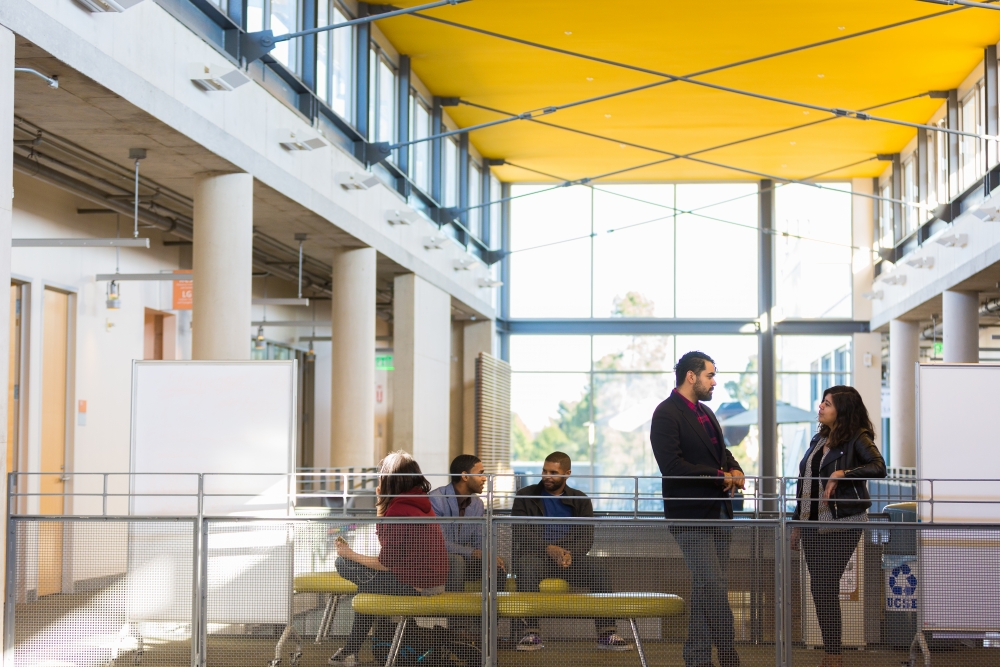
‘A Promising Model’
The big goal? To create a more diverse STEM faculty at colleges and universities nationwide. How to achieve it? First join forces with three other institutions here at home in California and develop a model that’s applicable — and replicable — in other states.
That’s the approach according to UC Santa Barbara, which initiated and is the lead institution on a new effort to do exactly that.
A partnership of UC Santa Barbara, UC Merced, CSU Channel Islands and CSU Fresno, has been awarded $2 million from the National Science Foundation’s Alliances for Graduate Education and the Professoriate program for a joint research project intended to increase underrepresented minority faculty in STEM (science, technology, engineering and mathematics) fields.
The endeavor is one of only three such alliances to be funded by the agency this year. All four campuses in the collaboration are designated Hispanic-Serving Institutions.
“This project develops a model of cross-institutional partnerships that other state university systems can follow,” said Carol Genetti, dean of the graduate division at UC Santa Barbara. “UC and CSU have shared goals: we both want to ensure that future faculty are well trained to be effective teachers and have successful professorial careers in our institutions. Since UC produces the majority of doctorates in the state, we are the primary source of the higher-education workforce. CSU’s partnership allows us to educate our students on the many opportunities offered at CSU campuses, how to prepare for a CSU faculty position and how to have a successful and satisfying career once there.
“Working with other institutions expands our views of higher education in California and beyond, and gives us a renewed sense of our broader societal mission,” Genetti added.
Graduate Division leaders at UC Santa Barbara, working with co-PIs David Sherman, a professor of psychological and brain sciences, and Anne Charity Hudley, a professor of linguistics, were inspired to write the project proposal after realizing that doctoral students interested in teaching at a broad range of colleges and universities — not just a tier one research institution such as UCSB — needed experience and training outside their home campus to be as prepared as possible. To get a better understanding of the type of training and mentoring that would facilitate those career pathways, they interviewed CSU professors who had earned their doctorates at UCSB.
“We realized that in the California context, one important but sometimes underappreciated pathway to the professoriate may be to work at local, minority-serving institutions, including universities in the California State University (CSU) system,” said Mary Hegarty, associate dean of UCSB Graduate Division and principal investigator on the grant. “This led us to develop an alliance between four Hispanic-serving institutions.”
“Its funding indicates that the National Science Foundation judged our proposal to be both innovative and a promising model for increasing participation of historically underrepresented students in the professoriate,” said Hegarty.
The project will see the partner institutions embark on a joint training program that incorporates CSU teaching experience, mentorship, networking opportunities and career preparation for UC Ph.D. trainees.
Ten doctoral students — five from UC Santa Barbara, five from UC Merced — will first participate in a teaching institute to learn about pedagogical practices for CSU. Each of those students will then be paired with a CSU professor-mentor and apply that knowledge as a teaching fellow for a CSU undergraduate course. Later in the 3- to 5-year program, participating students will receive career advice and support with professional networking as they complete their dissertations and enter the job market.
The project’s research component will investigate attitudes and assumptions of Ph.D. students and faculty members regarding the pursuit of different career paths, from teaching to industry to research-focused academic positions.
“We will see where there is convergence and divergence in the career goals that Ph.D. students have and that advisors have for their students, as well as doctoral students’ perceptions of faculty members’ views,” explained Sherman. “Ultimately, this will be useful information for students and faculty alike as there is potential for misunderstanding about how these important choices are viewed.”
“Useful information indeed,” concurred Carlos Nash, director of diversity initiatives in UCSB’s Graduate Division, and co-PI and academic coordinator on the project.
“While participation of underrepresented minorities in STEM Ph.D. programs is increasing, they are not making the transition to the professoriate at the same rate as other students,” Nash said. “The National Science Foundation has recognized the need for a diverse professoriate to prepare our future STEM workforce, which is increasingly racially and ethnically diverse. The interest in teaching-focused careers expressed by diverse Ph.D. students along with the model to be developed with this grant, therefore, has the potential to meet the goals of the NSF and other state institutes to diversify knowledge, teaching, and research to better match the changing student demographics.”



